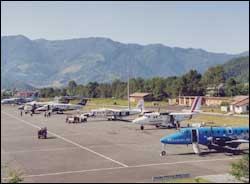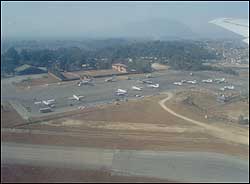 On Tuesday evening, a Buddha Air Kathmandu-Biratnagar flight flew by mistake to Bhairawa. Given the present rush in domestic airline traffic and the chaos at the terminals, a slip-up like that was bound to happen sooner or later. Domestic airline executives say they are reaping a bonanza because security concerns along highways have diverted travellers to fly rather than drive. But they add that traffic is reaching saturation point because of capacity and infrastructure bottlenecks.
On Tuesday evening, a Buddha Air Kathmandu-Biratnagar flight flew by mistake to Bhairawa. Given the present rush in domestic airline traffic and the chaos at the terminals, a slip-up like that was bound to happen sooner or later. Domestic airline executives say they are reaping a bonanza because security concerns along highways have diverted travellers to fly rather than drive. But they add that traffic is reaching saturation point because of capacity and infrastructure bottlenecks. Domestic airline capacity has been severely cut because airlines with larger aircraft like Necon have grounded their 50-seater ATRs and Cosmic is only operating one of its SAAB 340s. This means airlines with smaller planes like Buddha, Yeti, Skyline, Sita and Gorkha are stretched to the limit to pick up the slack.
Because of its larger fleet of six Beechcraft, Buddha has profited the most from the current crunch, carrying nearly half of all domestic passengers since Dasai. But its managing director, Birendra Basnet, says the traffic will drop off once the buses start running normally again. Basnet also says airlines don't like to work under such pressure. "It is difficult to maintain schedules and we have to make sure our customers are happy," he told us.
In an effort to meet passenger demand, Buddha has shunted nearly all its Biratnagar and Bhairawa flights to late evening and night because they are the only airports with night-landing facilities. Nepalganj's nightlanding is out of action because of technical problems with equipment, making matters worse. With morning fog in Kathmandu, there just aren't enough hours in a day to fly everywhere.
The unexpected turnaround in tourist traffic also caught domestic airlines unawares, although they aren't complaining about it. Domestic airlines make most of their profit from dollar-denominated tourist rates on flights. A tourist on a Pokhara-Jomsom flight, for instance pays nearly four times more than a Nepali. Another money spinner is the Mt Everest sightseeing flight which costs $100.
 On a single day last week, there were 25 flights to Lukla, Pokhara saw a record 107 flight movements on a single day in mid-October during a Maoist bandh, and Kathmandu airport has been regularly servicing over 250 takeoffs and landings a day, most of them planes on domestic routes. "The airport is as busy as it was during the Visit Nepal Year in 1998," one airport official told us.
On a single day last week, there were 25 flights to Lukla, Pokhara saw a record 107 flight movements on a single day in mid-October during a Maoist bandh, and Kathmandu airport has been regularly servicing over 250 takeoffs and landings a day, most of them planes on domestic routes. "The airport is as busy as it was during the Visit Nepal Year in 1998," one airport official told us. Even state-owned Royal Nepal Airlines is responding to the demand. With seven Twin Otters, it has the largest fleet among domestic airlines but till last month only two of them were airworthy. "We made it a priority to get them flying again, and now we have five in the air," says Captain Vijay Lama, head of domestic operations.
Despite the surge in traffic, domestic operators have been cautious about expansion. If Necon starts flying both its ATRs, for instance, a lot of the pressure on other carriers could immediately ease. But that doesn't look likely.
Fish Tail's Bikash Rana, for one, has decided that this is the right time to expand. He has sold off his Ecuriel helicopters to plan an ambitious foray in domestic routes with used Fokker F-50s. "There is a demand for domestic air seats which are not being met, we will fill it," he told us.
After its initial phenomenal growth following deregulation in the early 1990s, the domestic airline industry has seen a shakeout as the fly-by-nights go bankrupt, and only the professionally-run and efficiently managed airlines survive. At one point the number of operating license holders had reached a staggering 44. Nepal's domestic aviation history (and the apron at Kathmandu airport) is littered with the rusting hulks of airlines that didn't quite make it: Mountain Air, Lumbini, Flight Care, Nepal Airways, Everest Air.
Airline owners blame faulty taxation and inconsistent civil aviation policy for their plight. They complain that they have no more tax holidays nor can they import spare parts at reasonable custom duties like they did in the past. "Initially, the policies were right and helped us grow, but they changed policies midstream and that has threatened our existence," Rana explains.
 The other factor is the downtrend in tourism since 1999 and especially post 9/11 when airline insurance premiums went up. In fact, the airlines that have survived are the ones who don't solely depend on tourist traffic and derive a proportion of their income from operating trunk routes.
The other factor is the downtrend in tourism since 1999 and especially post 9/11 when airline insurance premiums went up. In fact, the airlines that have survived are the ones who don't solely depend on tourist traffic and derive a proportion of their income from operating trunk routes. Officials with Civil Aviation Authority of Nepal (CAAN) charge private airliners with mishandling their companies. They say if policies were wrong, all airlines should have been equally badly affected. Even some private operators agree with that. "It all depends on whether you want to get rich quick, or you want to build an institution," says Buddha's Basnet. "Those who run airlines professionally have been able to sustain themselves."
To be sure, government policies have been haphazard and ad-hoc. The mandatory requirement for airlines to ensure that 40 percent of their flights are to non-tourist destinations and remote areas is not enforced anymore. When asked, a senior CAAN official passed the buck to the ministry saying they aren't allowed to exercise autonomy on policy-decisions.
Some investors are now flexing their wings to fly international routes. After keeping application in deep freeze, CAAN has finally selected Air Shangri-La and Cosmic Air for international licenses. Air Shangri-La has permission to fly as far as Munich via Sharjah and other destinations, provided at least one of its two aircraft is widebody. Cosmic has asked for regional destinations, mainly in India and is required to operate at least one jet. Both have one year to start operations, or else they will go the way of previous ill-fated attempts to start private international airlines.


